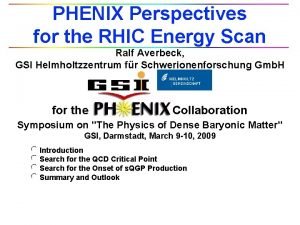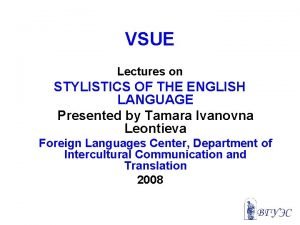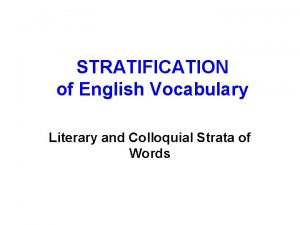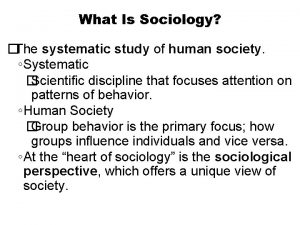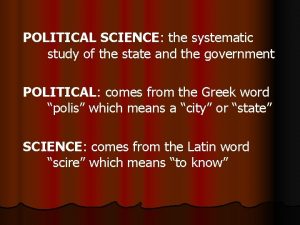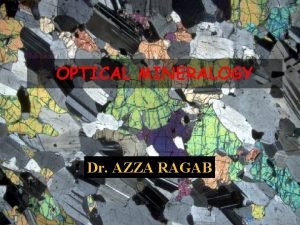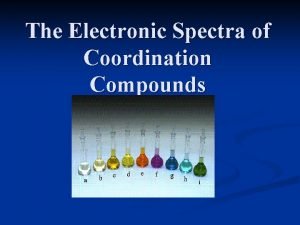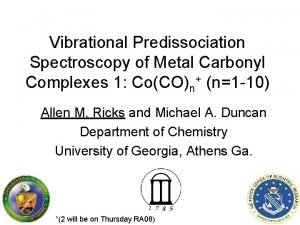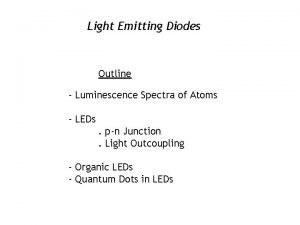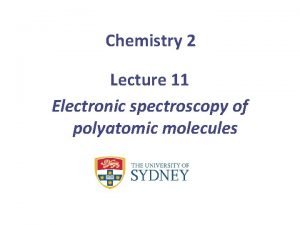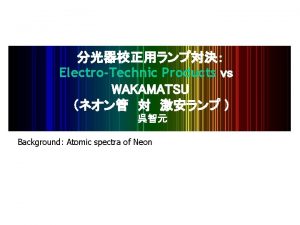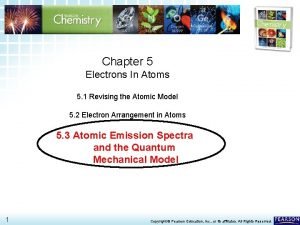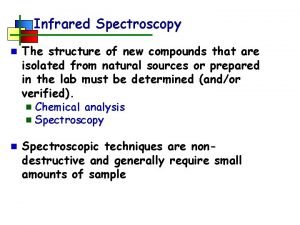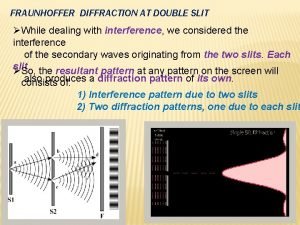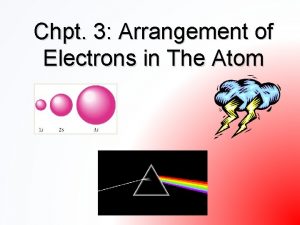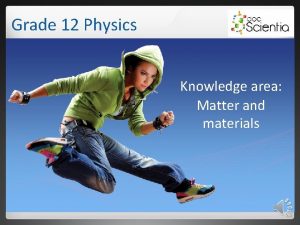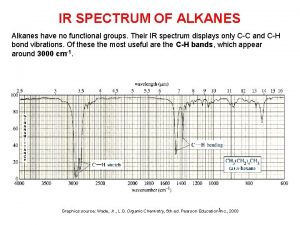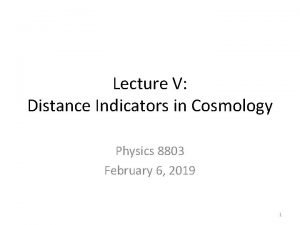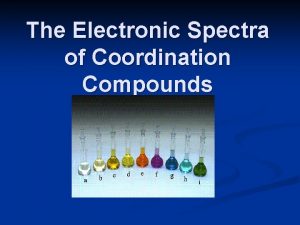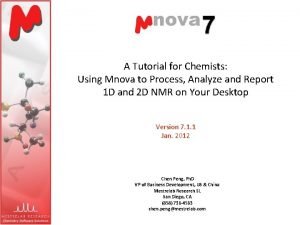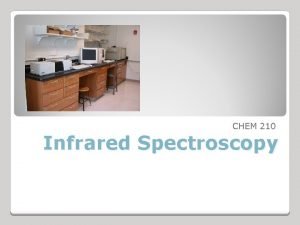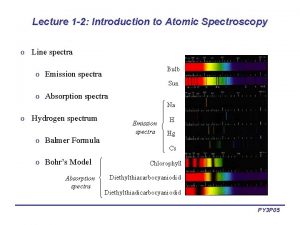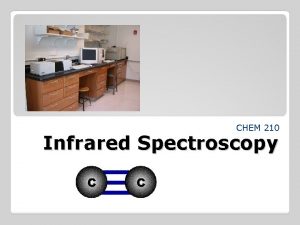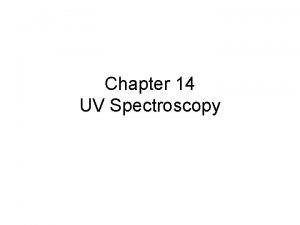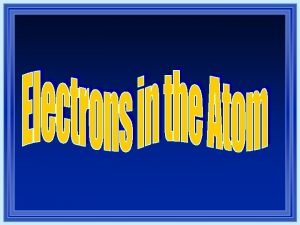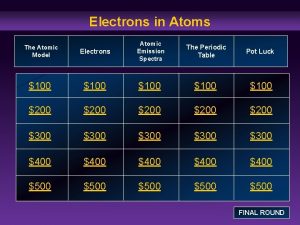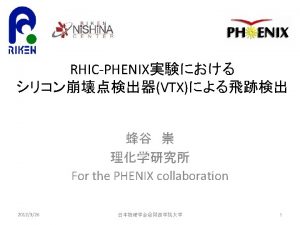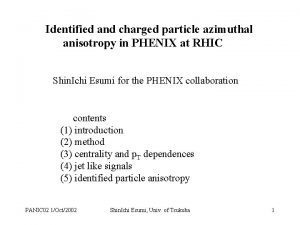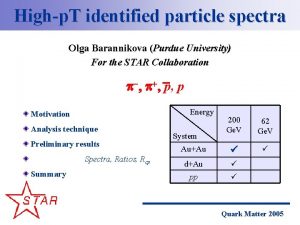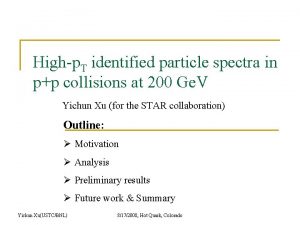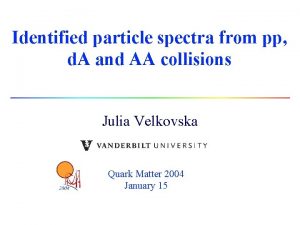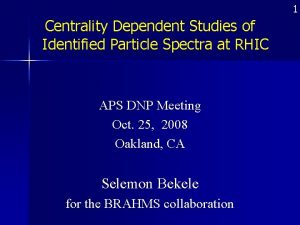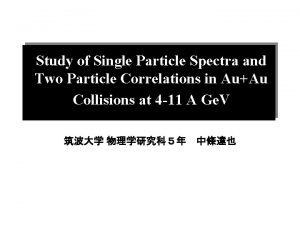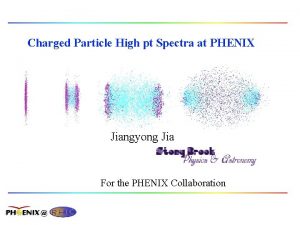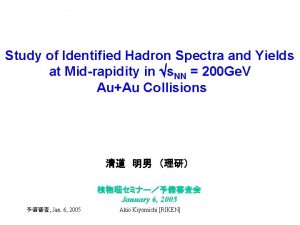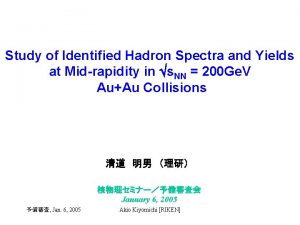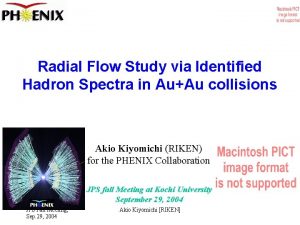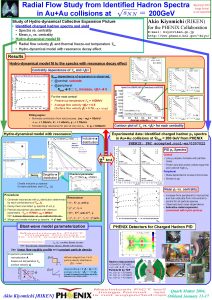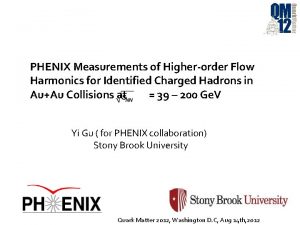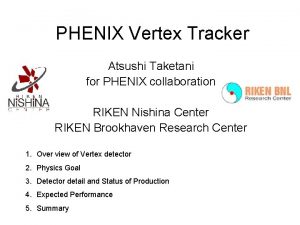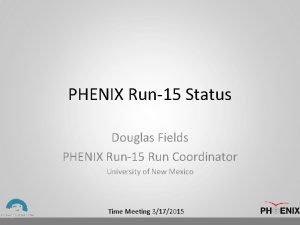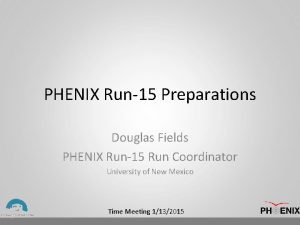Systematic study of identified particle spectra at PHENIX
































- Slides: 32

Systematic study of identified particle spectra at PHENIX Máté Csanád (Eötvös University, Budapest) For the PHENIX collaboration • PHENIX PID • 200 Ge. V Au+Au, d+Au and p+p – p. T spectra – what do we learn from it • Buda-Lund hydro fits to spectra – indication for deconfinement – Hubble-flow

Charged Hadron PID • Detectors involved: – BBC: start time – DC, PC: tracking, pt – TOF: Time of Flight PHENIX detector system • Acceptance: – | | < 0. 35 – = /4 PHENIX High Resolution TOF Au+Au √s = 62. 4 Ge. V • PID by TOF: – – – : up to 3 Ge. V/c K: up to 2 Ge. V/c p: up to 4 Ge. V/c s. TOF = 100 -130 ps dp/p= 0. 7% 1. 1%p M. Csanád, LLWI’ 05 2/14

200 Ge. V Au+Au • 20 M Min. Bias Au+Au events – feed-down corrected (for weak decay) • Central collisions – low-p. T slopes decrease with particle mass – protons and pions close at high p. T • Peripheral coll’s – weaker mass dependence – similar to d+Au M. Csanád, LLWI’ 05 3/14

200 Ge. V d+Au and p+p • 42 M Min. Bias d+Au events at 200 Ge. V – 88. 5± 4% of all events – feed-down corrections • 25 M Min. Bias p+p events at 200 Ge. V – 51. 6± 9. 8% of all events – feed-down corrections • Both similar to Au+Au peripheral M. Csanád, LLWI’ 05 4/14

How do we learn from this? • Nuclear modification factor – Scale down Au+Au spectra by Ncoll, compare to p+p • Ncoll: number of binary nucleon-nucleon collisions (from Glauber geometry), is 1 in p+p – The ratio is the nuclear modification factor • measures the effects of nuclear matter • hydro: scaling rather with number of participants • Hadron ratios – Negative versus positive particles • thermalization: ratio should be one (equal mass) • case of protons: nonzero initial baryon-number – Protons versus pions • collective dynamics effects • baryon yield enhancement M. Csanád, LLWI’ 05 5/14

Nuclear modification factor • Peripheral Au+Au similar to d+Au • Pions: suppressed in central Au+Au • Protons: significant enhancement for every collision type • Different mechanisms present here PRELIMINARY M. Csanád, LLWI’ 05 6/14

Negative vs. positive • Collision species and p. T independent • Sign of thermalization • Small net baryon density small, finite m. B PRELIMINARY M. Csanád, LLWI’ 05 7/14

Proton to pion ratio • Peripheral Au+Au and Minimum Bias d+Au have the same behavior • Central Au+Au p/p ratio much larger PRELIMINARY • Not in the baseline systems • Protons pushed forward to higher p. T • Baryon yield enhancement: only in hot, dense nuclear matter M. Csanád, LLWI’ 05 8/14

Buda-Lund hydro • 3 D expansion, symmetry • Local thermal equilibrium • Analytic expressions for the observables (no numerical simulations, but formulas) • Reproduces known exact hydro solutions (nonrelativistic, Hubble, Bjorken limit) • Core-halo picture M. Csanád, LLWI’ 05 9/14

A useful analogy Fireball at RHIC • • • Core Halo T 0, RHIC Tsurface, RHIC RG Rs – (Ts=T 0 Rs ) • t 0 • <bt> • <bt'> – Note: ut 2 = bt 2/(1 -bt 2) Fireball Sun Solar wind T 0, SUN 16 million K Tsurface, SUN 6000 K Geometrical size Radius where T = T 0/2 Radiation lifetime Radial flow of surface (~ 0) Radial flow at r=Rs M. Csanád, LLWI’ 05 10/14

Buda-Lund fit results • T 0>Tc by 2 -5 s, indication for deconfinement in Au+Au and p+p, based on lattice QCD (Tc 162 Me. V) • Finite Rs at the freeze-out not phase transition, crossover • No radial flow in p+p Hubble, spectra slope T 0 1 D • 3 D Hubble flow in Au+Au (1/ 0 ut’/Rs) • CERN SPS also fitted, but T 0<Tc there! M. Csanád, LLWI’ 05 11/14

Big Bang vs. Little Bang • Developed Hubble-flow at RHIC and in the Universe – Universality of the Hubble expansion: un= H rn • Hubble constant of the Universe: – H 0= (71 ± 7) km/sec/Mpc – converted to SI units: H 0= (2. 3 ± 0. 2)× 10 -18 sec-1 • Hubble constant in Au+Au collisions at 200 Ge. V – HRHIC, long = <ut’>/Rs (3. 8 ± 0. 4)× 1022 sec-1 – HRHIC, trans = 1/ 0 (5. 1 ± 0. 1)× 1022 sec-1 • Ratio of expansion rates: – HRHIC / H 0 2× 1040 • Really equals approx. the ratio of the ages! – 15× 109 yrs vs. 7 fm/c M. Csanád, LLWI’ 05 12/14

Summary and conclusions • p+p and d+Au data at the same energy as the “discovery energy” at RHIC, √s. NN = 200 Ge. V – New the baseline spectra – Made a lot of comparisons possible • Nuclear modification factor measured – d+Au similar to peripheral Au+Au – Pion suppression in central Au+Au • Hadron ratios also measured – Indication for thermalization – p/ enhancement only in central Au+Au • Successful Buda-Lund hydro fits – Indication of deconfinement in Au+Au and also p+p – 3 D Hubble flow in Au+Au, no radial flow in p+p – Crossover, not phase transition M. Csanád, LLWI’ 05 13/14

PHENIX Collaboration Brazil China University of São Paulo, São Paulo Academia Sinica, Taipei, Taiwan China Institute of Atomic Energy, Beijing Peking University, Beijing France LPC, University de Clermont-Ferrand, Clermont-Ferrand Dapnia, CEA Saclay, Gif-sur-Yvette IPN-Orsay, Universite Paris Sud, CNRS-IN 2 P 3, Orsay LLR, Ecòle Polytechnique, CNRS-IN 2 P 3, Palaiseau SUBATECH, Ecòle des Mines at Nantes, Nantes Germany University of Münster, Münster Hungary Central Research Institute for Physics (KFKI), Budapest Debrecen University, Debrecen Eötvös Loránd University (ELTE), Budapest India Banaras Hindu University, Banaras Bhabha Atomic Research Centre, Bombay Israel Weizmann Institute, Rehovot Japan Center for Nuclear Study, University of Tokyo, Tokyo Hiroshima University, Higashi-Hiroshima KEK, Institute for High Energy Physics, Tsukuba * as of January 2004 Kyoto University, Kyoto Nagasaki Institute of Applied Science, Nagasaki RIKEN, Institute for Physical and Chemical Research, Wako RIKEN-BNL Research Center, Upton, NY Rikkyo University, Tokyo, Japan Tokyo Institute of Technology, Tokyo University of Tsukuba, Tsukuba Waseda University, Tokyo S. Korea Cyclotron Application Laboratory, KAERI, Seoul Kangnung National University, Kangnung Korea University, Seoul Myong Ji University, Yongin City System Electronics Laboratory, Seoul Nat. University, Seoul Yonsei University, Seoul Russia Institute of High Energy Physics, Protovino Joint Institute for Nuclear Research, Dubna Kurchatov Institute, Moscow PNPI, St. Petersburg Nuclear Physics Institute, St. Petersburg State Technical University, St. Petersburg Sweden USA 12 Countries 58 Institutions 480 Participants* M. Csanád, LLWI’ 05 Lund University, Lund Abilene Christian University, Abilene, TX Brookhaven National Laboratory, Upton, NY University of California - Riverside, CA University of Colorado, Boulder, CO Columbia University, Nevis Laboratories, Irvington, NY Florida State University, Tallahassee, FL Florida Technical University, Melbourne, FL Georgia State University, Atlanta, GA University of Illinois, Urbana-Champaign, IL Iowa State University and Ames Laboratory, Ames, IA Los Alamos National Laboratory, Los Alamos, NM Lawrence Livermore National Laboratory, Livermore, CA University of New Mexico, Albuquerque, NM New Mexico State University, Las Cruces, NM Dept. of Chemistry, Stony Brook Univ. , Stony Brook, NY Dept. Phys. and Astronomy, Stony Brook Univ. , NY Oak Ridge National Laboratory, Oak Ridge, TN University of Tennessee, Knoxville, TN Vanderbilt University, Nashville, TN 14/14

Thanks for Your attention Spare slides coming… M. Csanád, LLWI’ 05 15/14

High resolution TOF • Particles well separated PHENIX High Resolution TOF Au+Au √s = 62. 4 Ge. V M. Csanád, LLWI’ 05 16/14

200 Ge. V Au+Au, pions • Approximately power-low shape for all centralities • Faster fall with increasing p. T for more peripheral collisions M. Csanád, LLWI’ 05 17/14

200 Ge. V Au+Au, kaons • Approximately exponential shape in p. T for all centralities M. Csanád, LLWI’ 05 18/14

200 Ge. V Au+Au, protons • Corrected for weak decay feed-down effect – ~40% at 0. 6 Ge. V/c – ~25% at 4. 0 Ge. V/c • Clear centrality dependence of shape at small p. T M. Csanád, LLWI’ 05 19/14

Nuclear modification factor • Central Au+Au: – factor of 6 gap between protons and pions – different mechanisms present here PRELIMINARY • d+Au: – no pion suppression – proton enhancement also here M. Csanád, LLWI’ 05 20/14

Nuclear mod. Factor, Au+Au • Elementary hadronic reference: – p+p can be used – Do not have to use anymore the peripheral Au+Au, with its large uncertainties PRELIMINARY • Central Au+Au: – large suppression for pions – less for kaons • Peripheral Au+Au: – consistent with point-like scaling M. Csanád, LLWI’ 05 21/14

Nuclear mod. Factor, d+Au • Intermediate and high p. T : no suppression PRELIMINARY • Protons: significant enhancement • Pions: no enhancement • Direct measurement of s, no assumptions made PRELIMINARY M. Csanád, LLWI’ 05 22/14

d+Au central vs peripheral M. Csanád, LLWI’ 05 23/14

d+Au central vs peripheral M. Csanád, LLWI’ 05 24/14

Barion content versus s. NN • Smooth transition from SPS • Consistent with STAR’s L ratio M. Csanád, LLWI’ 05 25/14

62. 4 Ge. V Au+Au spectra • 37 M Au+Au events • Three centrality bins • Large proton content at intermediate p. T • The familiar 200 Ge. V picture reemerges • Antiprotons though are not as copiously produced as in the higher energy case M. Csanád, LLWI’ 05 26/14

Proton to Pion ratio • Significantly enhanced proton to pion ratio > 1 • Notice: protons and antiprotons are not feed-down corrected • Smaller antiproton to pion ratio ~0. 7 compared to the 200 Ge. V data • Indicates more baryon transport at 62. 4 Ge. V and less p-pbar pair creation • Weaker centrality dependence for both ratios compared to the higher collision energy M. Csanád, LLWI’ 05 27/14

Hadron ratios • Flat p. T dependence for all ratios • Same picture as in 200 Ge. V data • Smaller antiproton/proton ratio • Particle ratios (Central 0 -10%) PHENIX Preliminary – -/ + = 1. 097 0. 022 (stat. ) 0. 063 (sys. ) – K-/K+ = 0. 816 0. 027 (stat. ) 0. 046 (sys. ) – pbar/p = 0. 495 0. 012 (stat. ) 0. 029 (sys. ) √s. NN=200 Ge. V M. Csanád, LLWI’ 05 28/14

Hadron ratios • Antimatter/Matter ratios are flat with centrality. • K/p increases as a function of centrality. • p/p+ smal increase. • pbar/p- independent of centrality. • Ratios (Central 0 -10%): PHENIX Preliminary – K+/ + = 0. 199 0. 003 (stat. ) 0. 010 (sys. ) – K-/ - = 0. 148 0. 005 (stat. ) 0. 008 (sys. ) – p/ = 0. 156 0. 002 (stat. ) 0. 008 (sys. ) – pbar/ = 0. 070 0. 002 (stat. ) 0. 004 (sys. ) M. Csanád, LLWI’ 05 29/14

130 Ge. V Au+Au spectra M. Csanád, LLWI’ 05 30/14

Buda-Lund hydro model • The general form of the emission function: • Calculation of observables with core-halo correction: • Assuming special shapes for the flux, temperature, chemical potential and flow M. Csanád, LLWI’ 05 31/14

Buda-Lund fit results M. Csanád, LLWI’ 05 32/14
 Phenix scan
Phenix scan Scantrip
Scantrip Jargonisms
Jargonisms Jargonisms
Jargonisms Responding to economic pressures in ob
Responding to economic pressures in ob Systematic study in sociology
Systematic study in sociology Systematic study of society
Systematic study of society A systematic study of the risks that you face.
A systematic study of the risks that you face. It is the systematic study of the state and government.
It is the systematic study of the state and government. Azza spectra
Azza spectra Correlation diagram in coordination chemistry
Correlation diagram in coordination chemistry Vibrational spectra of metal carbonyls
Vibrational spectra of metal carbonyls Outline spectra
Outline spectra Electronic spectra of polyatomic molecules
Electronic spectra of polyatomic molecules Spectra sp200
Spectra sp200 Atomic emmision spectrum
Atomic emmision spectrum Ir spectra chart
Ir spectra chart Missing order in diffraction
Missing order in diffraction Emission line spectra
Emission line spectra Matter and materials grade 12
Matter and materials grade 12 Ir spectrum of alkanes
Ir spectrum of alkanes Electromagnetic frequency spectrum
Electromagnetic frequency spectrum Ir peak table
Ir peak table Spectra tips
Spectra tips Supernova spectra
Supernova spectra Electronic spectra of coordination compounds
Electronic spectra of coordination compounds Mnova stacked spectra
Mnova stacked spectra Spectroscopy formula
Spectroscopy formula Introduction to atomic spectra
Introduction to atomic spectra Ir peak for carboxylic acid
Ir peak for carboxylic acid Conjugation in spectroscopy
Conjugation in spectroscopy Why are atomic emission spectra discontinuous
Why are atomic emission spectra discontinuous Atomic emission spectra periodic table
Atomic emission spectra periodic table
